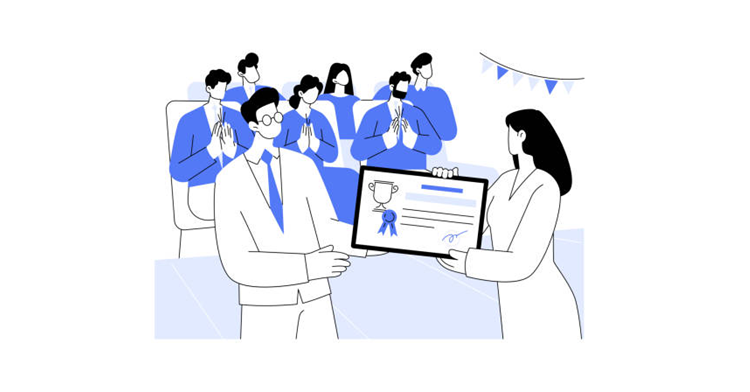1. Blue-collared employees, who are essential to the smooth operation of any organization, often go unrecognized for their contributions.
2. Recognizing and rewarding these employees is not just about fairness and boosting their self-esteem; it’s about creating a sense of belonging.
3. Best practices for recognition include verbal appreciation, monetary rewards, digital tools for immediate recognition, showcasing winners on display boards, and organizing award ceremonies.
4. Tailoring rewards to meet the unique needs of blue-collar workers helps keep them motivated and productive and fosters a culture of inclusivity.
Organizations focus primarily on their white-collared employees, including their office and supervisory staff. However, organizations need to pay equal attention to the rewards and recognition of blue-collared employees, who are integral to the workforce.
A Harvard Business Review analysis concluded that people working blue-collar jobs report lower levels of overall happiness in every region around the world.
Blue-collared employees often work silently behind the scenes, working on machines, delivering goods and services, performing repair and maintenance, ensuring workplace security, and doing other tasks integral to business operations.
They are the backbone of every organization but sadly do not get sufficient credit or recognition for their contribution.

The workforce in an organization is comprised of professionals in various roles.
They can broadly be classified into two main categories namely white-collared and blue-collared employees.

White-collar employees generally comprise those who work in professional, supervisory, managerial, and administrative roles within an organization.

On the other hand, members of the workforce, who work primarily in roles that require physical effort to perform their jobs are classified as blue-collar employees.
These employees are named so because most are required to wear uniforms, coveralls, and protective gear.
They include skilled manufacturing, mining, construction, logistics, and field services workers.

Blue-collared employees want to be acknowledged and appreciated for their hard work in the same manner as white-collared employees.
Organizations must recognize their contribution to the business even though these employees might handle hands-on tasks.
Making them an integral part of the employee rewards and recognition program is essential to keep them motivated and maximize their work quality and output.

Rewarding and recognizing blue-collared employees is essential to create a sense of fairness and equality within the workforce.
Such gestures help strengthen these employees’ sense of belonging and make them more appreciative of their employers.
Appreciating these employees, who work at the ground level, improves the overall productivity of the organization which helps enhance its success.
Recognizing blue-collared employees makes them feel doubly assured of being vital to the organization’s success.

The rewards and recognition offered to blue-collared employees should reflect the genuine gratitude and respect of the employers for their hard work and contributions.
Organizations should make sure that the employee recognition program highlights the importance of the tasks performed by these employees and how their contribution is important to the organization.
It should make the employees feel valued for what they are and what they contribute to making the business successful.

It is equally important to ensure that the rewards and recognition boost the self-esteem of blue-collar employees.
Employees should see some value and significance in the rewards being offered rather than just a mere formality.
The employees should feel assured about deserving the reward for contributing to the workplace and business growth.

Organizations must ensure that rewarding and recognizing blue-collared employees enhances their sense of belonging.
Rewards tend to boost the sense of commitment and loyalty among blue-collared employees and assure them of being an integral part of the workforce.
It also helps in building a more tolerant and inclusive work environment.
Organizations are often unsure about how to reward and recognize their blue-collar employees.
Here are a few best practices that can help organizations enhance the overall impact of recognizing these employees:

Organizations should encourage managers and supervisors to verbally appreciate the blue-collared employees regularly.
They should also habitually give appreciation and thank you cards whenever they spot any good work.
Employees feel assured that their work is noticed and acknowledged by their superiors.

Monetary rewards hold great significance for blue-collared employees and they prefer them over intangible rewards.
Most employees work at lower compensation and get minimal perks and benefits.
So, they value receiving monetary rewards as they can aid their financial wellness.

Organizations should consider using digital tools such as employee reward apps, digital recognition systems, and social media platforms to offer immediate recognition to blue-collar employees.
Using these digital tools also helps in making the recognition much more visible among the workforce.

It is important to showcase the names and pictures of award winners on LED/ physical display boards at the workplace.
This social visibility provides a sense of pride and achievement to the winners. It also makes it aspirational for other employees to emulate them.

Awards should be given out in floor meetings or other large gatherings, in the presence of other employees, supervisors, and management.
This gives excellent social visibility to the award winners and motivates them further.
Also read: Case Study: Employee Recognition at a Manufacturing Company
Blue-collared employees are the nuts and bolts that keep the organization running smoothly and seamlessly. Recognizing their efforts in a timely and appropriate manner is essential to keep them motivated and productive even during the most difficult times.
A one-size-fits-all policy for rewards and recognition might not work for them, as their needs differ from those of their white-collared counterparts.

Lead author: Sagar Chaudhuri, the Co-Founder and CEO of HiFives. He is an HR Tech Evangelist with over 25 years of corporate and entrepreneurship experience. In the past, Sagar has worked in leadership roles with companies such as Genpact, Infosys, and ICICI Bank. He has an engineering degree from IIT Kharagpur and an MBA from IIM Lucknow. Connect on LinkedIn
To stay updated on the latest HiFives blogs, follow us on Twitter (@MyHiFives)